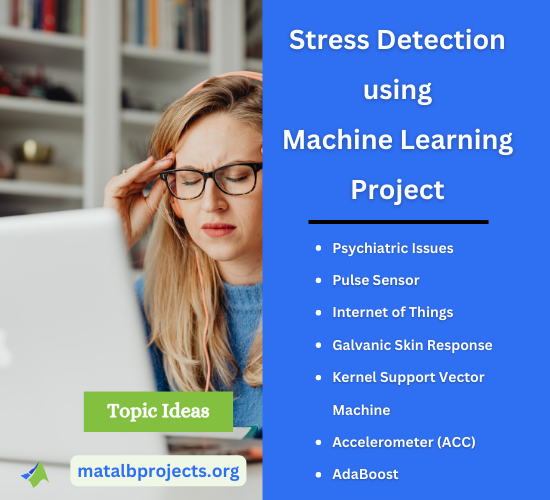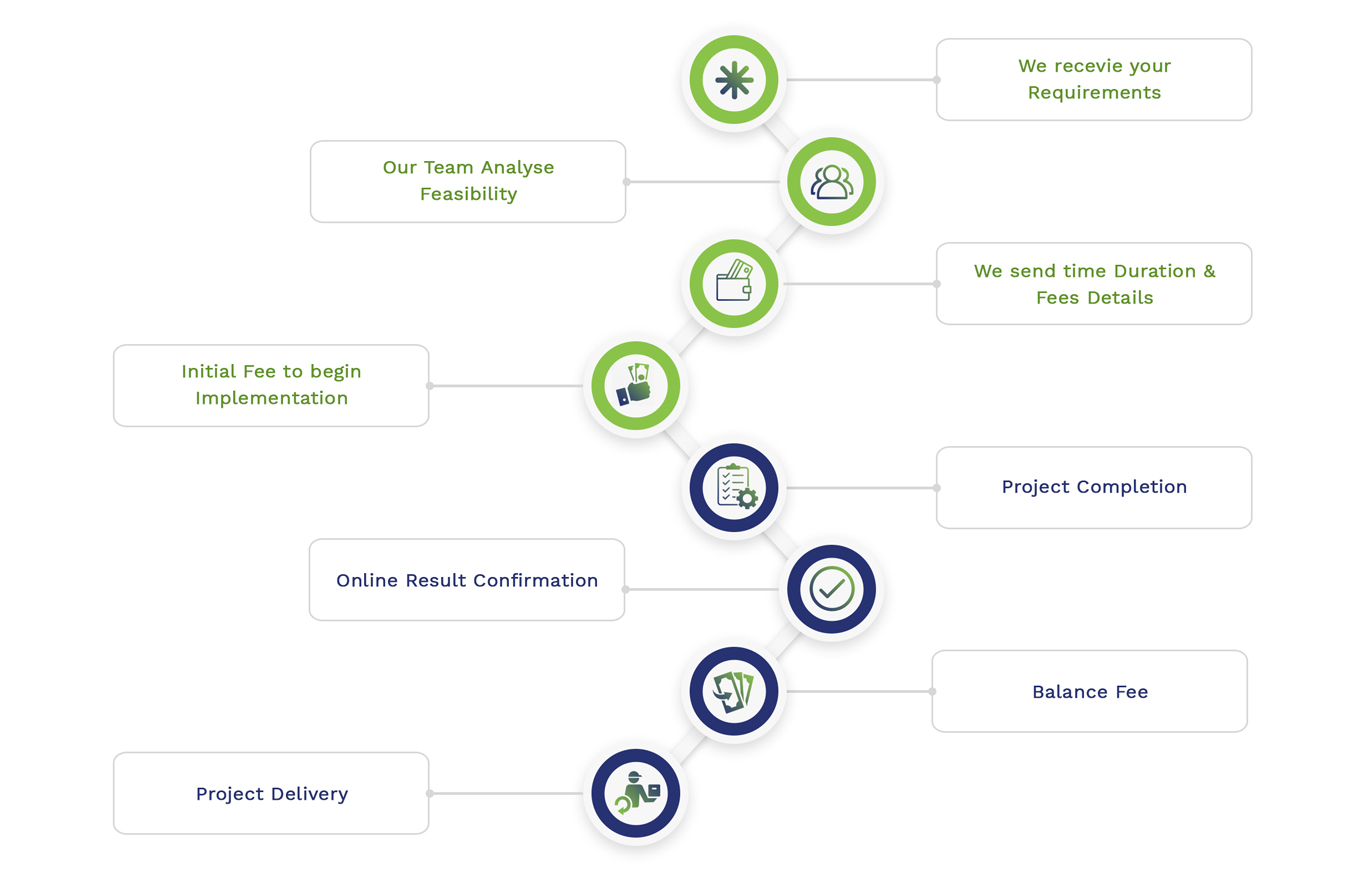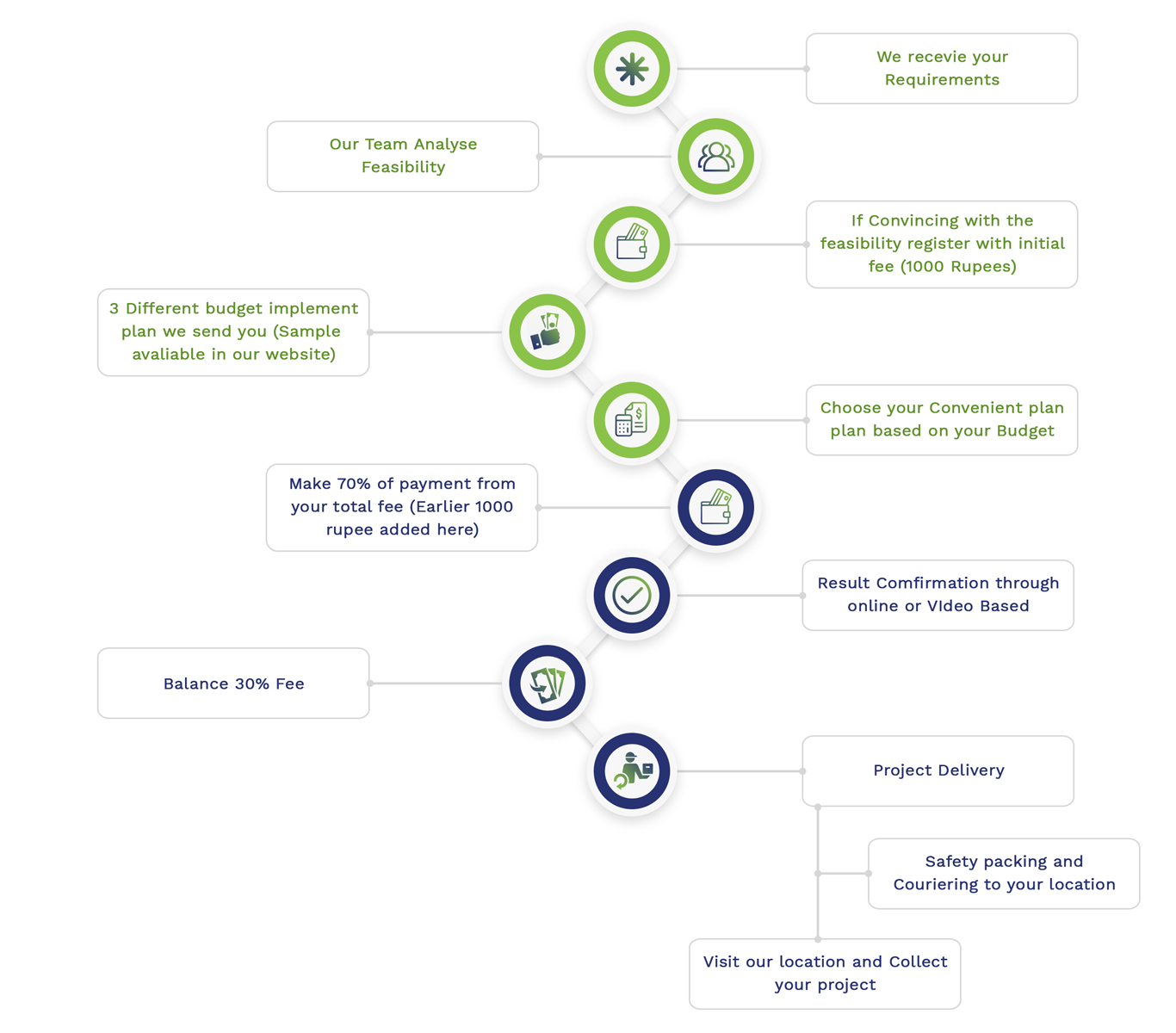Detecting stress using machine learning (ML) is an amazing and effective project. The method to predict stress differs on the type of data used. General approaches include observing physiological data, voice data and other textual data from user communications. Well published materials with all PhD expert solution will be given of fine quality for your project. Best project ideas on your area will be offered from top researchers. The following are the common steps that we implement in this project:
- Problem Definition:
Depending on the given data we examine the presence and absence of stress in a person.
- Data Collection:
- Physiological Data: We collect data from sensors like heart-rate trackers, wearable EEG devices and skin conductance sensors.
- Voice Data: Our project records audio samples of a person in various situations during stressed and non-stressed.
- Textual Data: By gathering text-based activities from chats and social media we find where the people express their emotions and feelings.
- Pre-processing the Data:
- We eliminate noisy signals and normalize data values especially for physiological data.
- In voice data we determine feature extraction algorithms such as Mel-Frequency Cepstral Coefficients (MFCC) and Chroma Short Time Fourier Transform (Chroma-STFT).
- For textual data our system does text cleaning, tokenization and other required NLP steps.
- Exploratory Data Analysis (EDA):
- Our model analyzes the dispersion by comparing stress with non-stress instances.
- We stimulate physiological signs under contrast stress with relaxed conditions.
- In textual data, discovering the general words and sentences that are related to stress are favorable for us.
- Feature Engineering:
- To analyze peaks, breaks and figures in heart rate, skin condition, etc. we require feature extraction in physiological data.
- Apart from MFCC our project includes characteristics such as pitch, intensity and speech rate for voice data.
- For textual data, our project employs methods such as TF-IDF and embedding like Word2Vec, FastText.
- Model Selection:
- Time series frameworks and CNNs are supportive for physiological and voice data. Random Forests, Gradient Boosted Trees, or SVMs are the approaches we gain in this.
- Determining LSTM, GRU and BERT like transformer-based frameworks are useful for textual data in our project.
- Training the Model:
- We instruct the model on the training set.
- To adjust any hyperparameters we insist on a test set.
- Evaluation:
- Accuracy: To balance datasets we implement accuracy.
- Precision, Recall, F1-score: When our model achieves class imbalance, these metrics are significant for us.
- ROC-AUC: It helps in interpreting the swap between true positive rate and false positive rate of our system.
- Optimization:
- In terms of the evaluation outcomes modifying our model’s structure and parameters.
- When needed, we analyze grouping techniques and latest frameworks.
- Deployment:
- Our system is combined into a wearable app for devices and environments where users communicate and express emotions in real-time stress prediction.
- Feedback Loop:
- To interpret false positives and negatives our project collects user ratings.
- For consistent model development we utilize these reviews.
Tools & Libraries:
- Data Handling & EDA: Pandas, NumPy, Matplotlib, Seaborn are the platforms that we employ in our model.
- Modeling: Scikit-learn, TensorFlow, Keras, PyTorch assist us in this process.
- NLP (when using textual data): NLTK, spaCy and transformers are useful in our project.
Final Ideas:
Stress forecasting by ML is a major technique probably in health and wellness applications. It is essential to examine the project with vulnerability, making sure data security and moral considerations. We often highlight that our tool helps in diagnosis but consulting with experts is crucial when dealing with health-related things.

Stress Detection Using Machine Learning Project Thesis Ideas
Our team stays awake on innovative solutions to guide you with best and original Stress Detection Using Machine Learning Project Thesis Ideas. Thesis Writing will be carried on as per your university guidelines without any plagiarism. Frequent updates of your work will be done so that you can acheive your target.
- Human Stress Detection Based on Sleeping Habits Using Machine Learning Algorithm
Keywords
Classification, Machine Learning, Sleeping Habits, Stress Detection
Our paper examines about detection of human stress based on sleeping behaviors. For classification process, we are using various ML methods like Multilayer Perception, Random Forest, Support Vector Machine, Decision Trees, Naive Bayes and Logistic Regression. Preprocessing of data is performed in this study. Naive Bayes method outperforms other methods in classification. At last, from the obtained results, we can detect the stress level of humans.
- Stress Detection through Wrist-Based Electrodermal Activity Monitoring and Machine Learning
Keywords
Stress measurement, emotion recognition, EDA, wearable sensors, wrist-worn wearable device, smart watches, k-nearest neighbors, support vector machines, naive bayes, logistic regression, random forest
A probability of utilizing wrist-based EDA signals gathered from wearable sensors to predict the human’s stress level and to detect the various factors that affecting the classification accuracy is examined in our article. We are utilizing several ML approaches to classify the stress level. We conclude that, Support Vector Machine provides optimal results than other methods. In this study, multimodal approach is also evaluated for stress classification.
- Automatic stress detection in car drivers based on non-invasive physiological signals using machine learning techniques
Keywords
Heart rate variability, Physiological signals
To detect the automotive driver’s mental stress based on the chosen biological signals such as respiration rate, ECG, GSR, and EMG, we suggested an innovative technique in this study. Various ML methods such as KNN, SVM, DT, LR, RF, and MLP are employed to categorize the mental state as stressed state or normal state. This stress detection technique includes preprocessing, feature extraction and classification procedures.
- Machine Learning based Detection of Post Traumatic Stress Disorder of Mental Health
Keywords
Artificial Intelligence, Deep Learning, Convolutional Neural Network, Technology, Physical Health, Mental Health
` Various research papers and studies for the prediction of mental state by using ML techniques are reviewed by utilizing PRISMA approach in our article. The gathered research studies are categorized to the related mental state problem such as anxiety, depression, bipolar illness, PTSD, and Schizophrenia. First, we will examine the results and then react to the issues related to mental health state.
- Early Detection of Anxiety, Depression and Stress among Potential Patients using machine learning and deep learning models
Keywords
Depression, Anxiety, Stress, psychiatric issues
In our paper, we are comparing three essential mental health states such as Depression, Anxiety, and stress by employing ML and DL approaches. Our work also examines about the performance of ML and DL methods in detection, diagnosis, and handling of mental health diseases. We are utilizing various methods like SVM, ANN and XgBoost in that SVM provides highest end results than others.
- Galvanic Skin Response based Stress Detection System using Machine Learning and IoT
Keywords
Internet of Things, Galvanic skin response, Pulse sensor
To develop an IoT related stress detection framework by employing Galvanic Skin Response (GSR) and pulse sensors are the main goal of our article. Modification in the electrical conductance of skin is examined by GSR sensor and the patterns in the heart rate that is related to stress is detected by pulse sensor. To process the data, signal processing technique is utilized and the essential features are extracted. The data will be sent to cloud for further processes.
- ECG Based Stress Detection Using Machine Learning
Keywords
Electrocardiogram (ECG)
In this paper, by employing ML techniques, we examined the stress by utilizing Electrocardiogram. To categorize the ECG signal as normal or stressed, we suggested a method that is DWT for the automatic detection of heart rate variability from R peak. This framework comprises of ECG data extraction, wavelet de-noising, R peak detection and categorization. To determine precise outcomes, ML method used several parameters acquired from categorization.
- A Low Cost EDA-based Stress Detection Using Machine Learning
Keywords
Health care information system
Our paper suggested a stress detection framework by utilizing EDA wearable sensors and ML approaches. Various distinct features are extracted from EDA signal. Then we performed normalization of data. After that, important features are chosen for stress detection. As a result, One-Leave-Out technique has the capacity to detect stress with highest accuracy.
- Stress Detection from Sensor Data using Machine Learning Algorithms
Keywords
Kernel Support Vector Machine, AdaBoost, Accelerometer (ACC), electro dermal, and Decision Tree
Utilization of ML approaches to detect the stress rate is the major aim of our study. We are considering various factors like heart rate, pulse rate, temperature and spo2 for stress detection. Bio signals are utilized to evaluate stress rate. To examine and compare the classification of stress, ML methods like Kernel SVM, KNN, AdaBoost, Random Forest and Decision Tree are employed. Results show that Random Forest outperform other ML methods.
- Stress Detection Using Physiological Signals Based On Machine Learning
A stress detection framework utilizing physiological signals like sweat gland activity on hand skin, heart rate, electromyogram and respiration is proposed in our article by using ML based techniques. Among various time intervals, the signals are segmented. After that, important features are extracted for classification process. We are using Support Vector Machine (SVM) and k-Nearest Neighbor (KNN) as classification techniques.
Subscribe Our Youtube Channel
You can Watch all Subjects Matlab & Simulink latest Innovative Project Results
Our services
We want to support Uncompromise Matlab service for all your Requirements Our Reseachers and Technical team keep update the technology for all subjects ,We assure We Meet out Your Needs.
Our Services
- Matlab Research Paper Help
- Matlab assignment help
- Matlab Project Help
- Matlab Homework Help
- Simulink assignment help
- Simulink Project Help
- Simulink Homework Help
- Matlab Research Paper Help
- NS3 Research Paper Help
- Omnet++ Research Paper Help
Our Benefits
- Customised Matlab Assignments
- Global Assignment Knowledge
- Best Assignment Writers
- Certified Matlab Trainers
- Experienced Matlab Developers
- Over 400k+ Satisfied Students
- Ontime support
- Best Price Guarantee
- Plagiarism Free Work
- Correct Citations
Expert Matlab services just 1-click

Delivery Materials
Unlimited support we offer you
For better understanding purpose we provide following Materials for all Kind of Research & Assignment & Homework service.
 Programs
Programs Designs
Designs Simulations
Simulations Results
Results Graphs
Graphs Result snapshot
Result snapshot Video Tutorial
Video Tutorial Instructions Profile
Instructions Profile  Sofware Install Guide
Sofware Install Guide Execution Guidance
Execution Guidance  Explanations
Explanations Implement Plan
Implement Plan
Matlab Projects
Matlab projects innovators has laid our steps in all dimension related to math works.Our concern support matlab projects for more than 10 years.Many Research scholars are benefited by our matlab projects service.We are trusted institution who supplies matlab projects for many universities and colleges.
Reasons to choose Matlab Projects .org???
Our Service are widely utilized by Research centers.More than 5000+ Projects & Thesis has been provided by us to Students & Research Scholars. All current mathworks software versions are being updated by us.
Our concern has provided the required solution for all the above mention technical problems required by clients with best Customer Support.
- Novel Idea
- Ontime Delivery
- Best Prices
- Unique Work
Simulation Projects Workflow

Embedded Projects Workflow



 Matlab
Matlab Simulink
Simulink NS3
NS3 OMNET++
OMNET++ COOJA
COOJA CONTIKI OS
CONTIKI OS NS2
NS2






